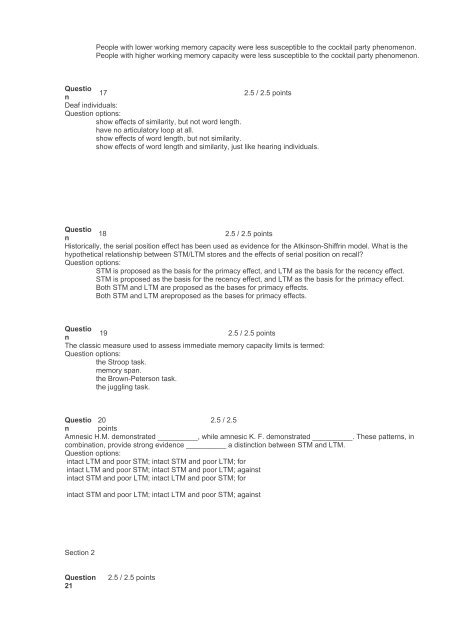PS400 Cognitive Psychology Exam 4&5 Answers (Ashworth College)
Create successful ePaper yourself
Turn your PDF publications into a flip-book with our unique Google optimized e-Paper software.
People with lower working memory capacity were less susceptible to the cocktail party phenomenon.<br />
People with higher working memory capacity were less susceptible to the cocktail party phenomenon.<br />
Questio<br />
17 2.5 / 2.5 points<br />
n<br />
Deaf individuals:<br />
Question options:<br />
show effects of similarity, but not word length.<br />
have no articulatory loop at all.<br />
show effects of word length, but not similarity.<br />
show effects of word length and similarity, just like hearing individuals.<br />
Questio<br />
18 2.5 / 2.5 points<br />
n<br />
Historically, the serial position effect has been used as evidence for the Atkinson-Shiffrin model. What is the<br />
hypothetical relationship between STM/LTM stores and the effects of serial position on recall?<br />
Question options:<br />
STM is proposed as the basis for the primacy effect, and LTM as the basis for the recency effect.<br />
STM is proposed as the basis for the recency effect, and LTM as the basis for the primacy effect.<br />
Both STM and LTM are proposed as the bases for primacy effects.<br />
Both STM and LTM areproposed as the bases for primacy effects.<br />
Questio<br />
19 2.5 / 2.5 points<br />
n<br />
The classic measure used to assess immediate memory capacity limits is termed:<br />
Question options:<br />
the Stroop task.<br />
memory span.<br />
the Brown-Peterson task.<br />
the juggling task.<br />
Questio 20 2.5 / 2.5<br />
n points<br />
Amnesic H.M. demonstrated __________, while amnesic K. F. demonstrated __________. These patterns, in<br />
combination, provide strong evidence __________ a distinction between STM and LTM.<br />
Question options:<br />
intact LTM and poor STM; intact STM and poor LTM; for<br />
intact LTM and poor STM; intact STM and poor LTM; against<br />
intact STM and poor LTM; intact LTM and poor STM; for<br />
intact STM and poor LTM; intact LTM and poor STM; against<br />
Section 2<br />
Question<br />
21<br />
2.5 / 2.5 points

















